Delicious Raspberry Cheesecake Croissant Creations

Tucked away in the back corner of my local bakery, one breakfast pastry stood out from the rest. Instead of the usual flaky rolls or sliced bread, there sat a basket of beautifully bronze-colored buns. My curiosity got the best of me and I had to take a closer look. Upon pulling one out, I was surprised by its weight and odd shape. Rather than a traditional bun shape, it was cylindrical – almost like a canoli without the curl. That’s when I noticed the name – “Cheesecake Croissant Buns”. Intrigued, I took a bite. The moment the light, crispy exterior gave way to the cool, creamy center, I was transported. Smooth cheesecake mingled with hints of buttery croissant in perfect harmony. From that moment on, I had to share the discovery of this unique pastry that brilliantly marries two beloved desserts.
Contents
- Cheesecake Croissant Buns
- What are Croissant Buns?
- How to Make Cheesecake Croissant Buns (‘Cups’)?
- How to Fill the Croissant Buns?
- Freezing the Dough
- Frequently Asked Questions (FAQs)
- 1. What is croissant dough?
- 2. Is croissant dough the same as puff pastry?
- 3. How do you make croissant dough?
- 4. Can I use puff pastry instead of croissant dough to make croissant buns?
- 5. Are croissant rolls healthy?
- 6. Is a croissant a Cake or bread?
- 7. What’s the difference between a croissant and a crescent roll?
- 8. What’s the difference between a croissant and a cream roll?
- 9. What is a substitute for croissant dough?
- 10. Can you use brown butter for croissants?
- 11. How many calories in a croissant bun?
- Cheesecake Croissant Buns
Cheesecake Croissant Buns
Let’s delve into this mouthwatering creation. Upon splitting one open, the flaky croissant layers unravel to reveal ribbons of soft cheesecake nestled within.
What are Croissant Buns?
Croissant bun recipe employs the same laminated dough technique used to create traditional croissants, where butter is repeatedly folded between thin layers of dough to produce the distinctive incomparable flaky layers that bake up with a wonderfully crisp golden-brown exterior encasing a soft, fluffy center. Rather than being rolled and formed into the classic crescent shape, croissant buns are rounded into a dinner roll-like shape that is easy-to- handheld form, making them a familiar and convenient option for picking up and enjoying on the go rather than requiring a plate like their traditional layered counterparts.
With their signature shattering crust that gives way to a pillowy inside, cheesecake croissant buns provide all the texture and classic taste of a croissant in a unique hand-held package, opening up possibilities for enjoying this beloved bakery pastry anytime of the day as a breakfast, snack, or sandwich. Whether plain or filled with sweet or savory mixtures, croissant buns offer a delightful twist on the familiar indulgence of a croissant in easy-to- handheld form, perfect for looking to enjoy a little bit of bakery fare anywhere and any time.
How to Make Cheesecake Croissant Buns (‘Cups’)?
I’ve been trying to recreate those fluffy buns from my favorite café and think I’ve finally cracked the code with this copycat recipe. Following weeks of testing different doughs and baking techniques, I’ve developed a version that comes close to mimicking their signature billowing texture. Sharing my buns from home copycat recipe with friends, no one could believe they weren’t the real deal from the shop. Perfecting the slight sweetness and melt-in-your-mouth feel was tricky, but nailing this dupe recipe was worth the effort. Now friends won’t have to hit the café to enjoy these cozy treats.
While store-bought puff pastry is definitely the easiest route for those lacking the time or patience for homemade, I have found that making the croissant dough from scratch is not as complicated or sugar-coated a process as some break down. In my experience, the toughest part is simply finding the time for the multistep folding process, but even that can be broken up over a couple of days. With a little practice of the laminated dough technique discussed in the previous section, any home baker can usually achieve wonderfully crisp and flaky results worthy of any bakery simply by employing a few hours of hands-on time. For those seeking the ultimate indulgence of a true handcrafted croissant, I say skip the store-bought option and roll up sleeves to make these buns from scratch – the satisfaction is well worth any extra effort.
Make the Croissant (Laminated) Dough
Making croissant dough requires significant patience and included instructions, but taking your time with each step and being patient will result in a layered texture that is well worth the effort. As my grandma always used to tell me, “good things come to those who wait.” The toughest part for many is achieving the many thin layers through the lamination process, but with practice and focus on technique, the process becomes increasingly natural. I remember the first time I tried making croissants – it was a mess! But I kept at it and slowly started to get the hang of it. Now they’re one of my favorite things to bake. The sense of accomplishment after successfully creating those delicate layers is really rewarding.
Combine the dry ingredients in a large bowl and cut in 50g of softened butter until it resembles coarse crumbs. I find it easiest to cut the butter in with a pastry cutter until the mixture looks like coarse sand. In a stand mixer fitted with the hook attachment, knead the mixture on medium-high speed for 5–7 minutes until a smooth, elastic dough forms. I love seeing the dough come together as it kneads. Then add 50g more softened butter and continue kneading for 5 minutes until fully incorporated throughout the dough. It always amazes me how such a tender dough can form from these basic ingredients. Cover the bowl and let the dough rise for 1 hour at room temperature.
Once risen, chill the dough for at least 30 minutes before proceeding. I always find it’s best to give the dough a good chill to make it easier to work with. Roll the dough into a 5.5″x11″ rectangle and cover with cling wrap. Place in the freezer for 5 minutes, then refrigerate for 30 minutes. Meanwhile, take 130g of butter and place on a sheet of parchment paper folded to form a 5×5″ square. It takes some effort, but I find using a rolling pin, just like I’ve seen my mom do, to be the best technique for flattening and smoothing the butter into an even square shaped block.
Refrigerate the butter for 15 minutes before encasing it in the dough rectangle. I always get great satisfaction from neatly folding and sealing in the butter square. Folding ensures those delicate layers will develop nicely. Roll out gently to a large rectangle, 1cm thick. Performing multiple turns, folding and chilling the layers is key to developing that marvelous texture everyone raves about. I find it rewarding how with each turn the layers become more defined. Refrigerating 30–60 minutes is important for letting the gluten relax before proceeding. Then rolling out the dough to a 9×16″ rectangle takes careful work, but the even shape makes shaping so much easier.
Shape and Bake the Croissant Cups
Now that the dough is ready, it’s time to shape the croissant cups. Following a slightly different method than a traditional croissant recipe calls for, we’ll be cutting the large rectangle of dough into triangles, rather than rolling them up. First, I like to coat the backside of a muffin tray with butter to prevent sticking, then chill it. Roll out the croissant dough to a 9″x16″ rectangle, using the dimensions from the previous rolling step. I find it helps to dust the work surface with a bit more flour if needed to keep the dough from sticking. Then I’ll divide this into two rectangles: one 3″x16″ and one 6″x16″. The smaller piece goes in the fridge to keep it chilled.
Now, I cut the larger into nine strips along its length, with each around ~0.7″x16″. Being precise with the cuts takes practice but makes assembling the cups so much easier. Carefully wrap the strips one by one around the edges of the muffin cups, starting at the bottom and working my way up. I take it slowly to ensure a tight seal with no gaps. Using my warm fingers, I gently press the strips together to seal them neatly. If the dough starts to get too warm while working, I’ll pop it in the fridge to chill for a bit – it’s much easier to shape when cold. It’s best to only work with one strip at a time so they don’t overproof.
Now it’s time to cover the bottoms of the cups using the pastel de nata technique. I love this traditional Portuguese method. I take the other rectangle of dough and divide it into two 3″x8″ rectangles. Then I roll each into a log shape along its length, like a cinnamon roll. Cutting these logs into nine to ten equal circular pieces requires a gentle hand. Working with one at a time and keeping the others chilled, I flatten and roll out each piece with a rolling pin to a size slightly larger than the uncovered cup bottoms. Taking my time at this stage ensures a clean finish.
I gently place the rolled out pieces on the muffin cups, then seal the edges with the strips already wrapped around, pressing with my fingers to adhere. An egg wash also helps further seal together the pieces. Repeating this process for all cups ensures they’re completely and neatly shaped. Once finished, I let them proof at room temperature for two hours, or until looking puffed up and airy.
Proceeding to bake at 350°F for 20–25 minutes, until the tops are a deep golden brown. I find covering the muffin pan with a light sheet pan during the last 10–15 minutes helps crisp and flatten the bottoms. Stopping to chill the dough when it gets too warm enables successful shaping. With a bit of patience, soon that wonderful yeasty, buttery aroma comes wafting from the oven! There’s nothing like enjoying the fresh pastries straight out of the oven. The process of making these from scratch is so gratifying.
Cream Cheese Filling
For me, half the joy of baking these croissant cups is getting to dream up different sweet fillings. A favorite in my house growing up was always a cream cheese filling, so it feels like the perfect nostalgic option. In a medium-sized glass mixing bowl that my mom passed down, I whisk the cream cheese and sugar together until fully smooth and glossy. Then I add a splash of sour cream for tang, a squeeze of fresh lemon juice for brightness, and a teaspoon of vanilla for warmth.
Once those flavors are incorporated, it’s time for the fun part – decorating the pastry shells. In my stand mixer, I whip the heavy cream until billowy soft peaks form. This whipped cream gets gently folded through the creamy cheese base until just blended. The filling is then scooped or piped using one of my vintage couplers into the baked cups. Biting into that soothing blend of flavors never gets old. My hopes are that making this recipe brings back for others the same comforting memories it holds for me. Bon appétit!
RELATED: Easy Yogurt Parfaits Recipe
Raspberry Glaze
For the glistening glaze, I heat 2/3 cup raspberry jam with 2 tablespoons each water and sugar in a small saucepan over low heat. As the mixture bubbles and starts to form a thick glaze like syrup, I stir gently. Once opaque and syrupy, I let it cool on the stove top for 5–10 minutes, stirring occasionally to release the sweet raspberry scent throughout my kitchen.
How to Fill the Croissant Buns?
After all the measuring, rolling, and shaping, the easy, fun part is finally here – assembling the finished pastries! Once the cups have cooled, I remove them carefully from the muffin pan, gently pulling each one apart with my fingertips. I place the hollow bases onto a large serving dish, ready for filling.
This has always been my favorite step as a kid, helping mom in the kitchen. I fill the insides generously with the homemade no-bake cheesecake mixture using a small spoon or piping bag. Adding a final touch of raspberry glaze on top makes the filling practically glow within the golden crust. I then top off each bun with a sprinkle of crushed graham crackers for extra crunch and flavor.
The whole dish goes straight into the refrigerator to set for 2–3 hours, ensuring the creamy center firms up. I’ve learned from experience that it’s important not to overtake the cups beforehand so they remain crispy even when filled to the brim. Properly chilled, these indulgent stuffed buns are ready to serve family and friends, transporting our taste buds back to sun-drenched summer afternoons. Cheesecake croissant bun is also versatile – it can be enjoyed on its own or split open to create a delicious croissant bun sandwich.
Freezing the Dough
Now that your homemade croissant dough has been perfectly crafted through multiple turns and folds, there are a couple options for freezing it so you can use the baked goods later:
- Use half the dough right away, then freeze the remaining rolled out portion for up to two weeks. Carefully wrap the frozen slab nicely in plastic wrap followed by foil to prevent drying out. To use, simply thaw the dough in the fridge overnight and proceed with the shaping/baking instructions as usual.
- Freeze the dough anytime after completing the lamination process of folding in butter layers. Shape into a fat log, wrap well in plastic film and then an outer layer of foil. When ready to bake, thaw the log in the fridge for 1–2 days, unwrap and let sit at room temp to soften before continuing with the recipe as normal.
Whether baking a fresh batch today or preparing the dough in advance, these tips ensure your flaky creations will be ready to enjoy whenever a craving strikes!
Final Thoughts
In the end, cheesecake croissant buns are a delicious treat, whether enjoyed as part of a meal or on their own. The techniques to create the feathery layers may require practice, but homemade versions allow you to customize flavors and fillings to your liking. Sharing homemade croissant buns with others is a great way to spread joy through something as simple as breakfast. The flaky texture and buttery taste seem to brighten anyone’s day.
Frequently Asked Questions (FAQs)
1. What is croissant dough?
Croissant dough is uniquely different from your average bread in that it is a laminated type of bread dough. The process of laminating simply means layering fat, such as butter, between thin sheets of dough. This technique is what allows croissants to have their signature flaky, buttery layers once baked.
To start, a basic yeasted bread dough, or Détrempe as it’s called in French, is made. Then the process known as Beurrage occurs – the layering of softened butter between the dough. This creates hundreds of paper thin layers that are intricately folded multiple times. The resulting lamination traps pockets of air between each layer of fat and dough. During baking, the butter and water in these layers evaporate, causing the pockets to expand and create ultra-thin, separate layers. This process is what gives croissants their coveted flaky texture like no other bread.
2. Is croissant dough the same as puff pastry?
While both croissant dough and puff pastry fall under the category of laminated baked goods, they differ in their production, which results in a distinct texture for each. Puff pastry is more commonly made with an all-butter yeast-free pastry base that is folded and rolled, producing hundreds of layers. In contrast, croissant dough uses yeast and is kneaded like regular bread dough before butter is layered in. This creates a final product that is slightly crumblier and flakier than puff pastry once baked. The secret to achieving crisp croissants lies in the incorporated air pockets from the lamination of butter into the yeasted dough base.
3. How do you make croissant dough?
Making croissant dough involves first proofing the yeasted mixture before encasing a solid block of butter within the dough through a process of rolling out and folding. To achieve multiple thin sheets, one layers the butter using two different folds: a single fold and a double fold. Maintaining a cool temperature throughout lamination can be tricky, as it requires keeping the butter from melting into the dough.
4. Can I use puff pastry instead of croissant dough to make croissant buns?
For those lacking the necessary patience to craft homemade croissant dough from scratch, store-bought puff pastry can make a suitable substitute for making the buns – however the final outcome may not be quite as crispy. You’ll need to adjust the baking time following the package instructions, as puff pastry will bake up faster than laminated croissant dough. Overall, it can still yield a tasty treat in a pinch, just keep in mind the texture won’t be identical. But improvising with puff pastry is better than not enjoying the buns at all!
5. Are croissant rolls healthy?
Croissants, although tasty, do not qualify as a particularly healthy option due to their high fat and calorie content derived from the butter and egg yolks. A single croissant can contain over 200 calories and 10+ grams of fat. They are best enjoyed occasionally in moderation.
6. Is a croissant a Cake or bread?
A croissant is considered a bread rather than a cake. It is made with yeast-raised dough and has a savory flavor profile compared to sweet cakes. However, the lamination process of layering butter gives croissants a lighter and flakier texture than conventional breads.
7. What’s the difference between a croissant and a crescent roll?
Croissants are traditionally crescent-shaped, but have a richer, butter-enriched dough which results in distinctive layered flakes. The simpler dough, similar to biscuits, produces a softer texture in making crescent rolls. Croissants also tend to be larger.
8. What’s the difference between a croissant and a cream roll?
Laminated dough makes croissants a yeasted bread product, while cream rolls utilize a richer biscuit-style dough. Additionally, croissants do not contain any cream or sweet filling, whereas bakers stuff cream rolls with sweet pastry cream or confectioners’ cream filling before baking them.
9. What is a substitute for croissant dough?
Puff pastry can work in a pinch as a substitute for croissant dough. Though the texture won’t be exactly the same as authentic croissants, yeast-raised biscuit dough or pie crust dough could also accomplish the task.
10. Can you use brown butter for croissants?
Yes, brown butter can be substituted for regular butter when making croissant dough. Browning the butter first adds a nutty flavor that complements the sweetness of the croissants. It may require a slight adjustment to baking time, since brown butter has a lower moisture content.
11. How many calories in a croissant bun?
On average, a medium-sized croissant bun contains about 150–200 calories. This can vary depending on the exact ingredients and size, but as a reference, a 2 ounce croissant bun provides approximately 150 calories, 8 grams of fat, 18 grams of carbohydrates and 3 grams of protein. Compared to regular bread, croissant buns are higher in fat and calories due to their rich dough.
Cheesecake Croissant Buns
Course: Pies and Tarts4-5
Buns1
hour30
minutes15
minutes200
kcal1
hour45
minutesLight and flaky croissants filled with a sweet cream cheese filling. Decorated with berries, these cheesecake buns make a delicious breakfast or dessert.
Ingredients
- Croissant Dough:
70g milk
5g yeast (1.5 tsp)
50g water
125g all-purpose flour
125g bread flour
7g salt (1 tsp)
25g granulated sugar
1 tsp honey (7g)
50g butter, softened
130g butter for lamination
- Croissant Cups:
9×16” prepared croissant dough sheet
1 egg
1 tbsp milk
- Cheesecake Filling:
350g (12oz) cream cheese, room temperature
100g sugar
1 tsp vanilla extract
1/4 tsp salt
2-3 tbsp fresh lemon juice
130g sour cream
130g heavy cream, chilled and whipped to medium peaks
- Raspberry Glaze:
4 tbsp raspberry jam
2 tbsp water
1 tbsp sugar
2-3 graham crackers
Directions
- Croissant Dough:
- Add the dry ingredients except the 50g butter and 130g butter to a stand mixer fitted with a hook. Mix on medium-high speed for 5-7 minutes to combine thoroughly.
- Add the 50g softened butter gradually to the mixing dough. Continue kneading for 5 more minutes until the butter is fully blended in.
- Cover the dough and allow it to rise at room temperature for around 1 hour or until doubled in size.
- Once chilled, use a rolling pin to shape the dough into a 5.5″ by 11″ rectangle on a lightly floured surface. Wrap in plastic and refrigerate for 5 minutes, then 30 minutes.
- Place the 130g butter between folded parchment paper to form a 5″ square. Use a rolling pin to press the butter evenly into the parchment until flattened. Chill for 15 minutes.
- Enclose the chilled butter square inside the center of the dough rectangle. Fold over the dough and seal all edges neatly.
- Gently roll into a large 1cm thick rectangle. Keeping a short edge facing forward, fold down halves to form three layers.
- Refrigerate 10-15 minutes. Roll into a 7mm thick large rectangle. Fold both short edges into the center until meeting, then fold into halves to form 4 layers.
- Refrigerate 30-60 minutes. Roll to a 9″ by 16″ rectangle and proceed with shaping instructions.
- Croissant Cups:
- First, coat a muffin tray with butter and chill it. Roll out the croissant dough to a 9″x16″ rectangle on a floured surface. Divide this into a 3″x16″ rectangle and a 6″x16″ rectangle. Refrigerate the smaller piece and cut the larger into nine 0.7″x16″ strips along its length.
- Carefully wrap the strips around the edges of the muffin cups starting at the bottom and working up, sealing neatly without gaps. Chill the dough if it gets too warm while shaping.
- To cover the bottoms, divide the other 3″x8″ dough rectangles in half. Roll each into a log, then cut into nine to ten equal circular pieces. Working with one at a time, flatten and roll each piece slightly larger than the cup bottoms.
- Gently place the rolled pieces on the cups and seal the edges with the strips, pressing to adhere. An egg wash further seals the pieces together as they are repeated for all cups.
- Let proof at room temperature for two hours, until puffed up. Bake at 350°F for 20-25 minutes, until a deep golden brown, covering for the last 10–15 minutes to crisp the bottoms. Chilling the dough when warm enables shaping.
- Cheesecake Filling:
- In a medium-sized glass mixing bowl, whisk the cream cheese and sugar together until fully smooth and glossy. Then add a splash of sour cream for tang, a squeeze of fresh lemon juice for brightness, and a teaspoon of vanilla for warmth.
- In my stand mixer, whip the heavy cream until billowy soft peaks form. This whipped cream gets gently folded through the creamy cheese base until just blended.
- The filling is then scooped or piped using vintage couplers into the baked cups. Biting into that soothing blend of flavors never gets old.
- Raspberry Glaze:
- In a small saucepan over low heat, heat 2/3 cup raspberry jam with 2 tablespoons each water and sugar.
- As the mixture bubbles and starts to form a thick glaze like syrup, stir gently.
- Once the glaze is opaque and syrupy, let it cool on the stove top for 5–10 minutes, stirring occasionally to release the sweet raspberry scent throughout the kitchen.
- Final Assembly:
- Once the cups have cooled, carefully remove them from the muffin pan by gently pulling each one apart with fingertips.
- Place the hollow bases onto a large serving dish, ready for filling.
- Fill the cup interiors generously with the homemade no-bake cheesecake mixture using a small spoon or piping bag.
- Add a final touch of raspberry glaze on top to make the filling glow within the golden crust.
- Top each bun with a sprinkle of crushed graham crackers for extra crunch and flavor.
- Place the whole dish in the refrigerator to set for 2–3 hours, ensuring the creamy center firms up.
Notes
- If using a different croissant dough recipe, be sure to scale the recipe so that the total amount of all-purpose and bread flour adds up to 250g. This will ensure the dough can be properly rolled out into a 9×16 inch rectangle at the final step before shaping and baking. Follow all other instructions as written, substituting your preferred dough ingredients while maintaining the total 250g flour amount.
- If using ready-made frozen or refrigerated puff pastry dough instead of a homemade croissant dough, there is no need to proof the dough before baking. You can shape the puff pastry directly after assembling the filling. Baking time will also likely be shorter when using puff pastry – I recommend starting at 10 minutes baked without any added weight, then adding weight like baking beans or pie weights for the final 5-10 minutes of baking if additional browning is desired. Keep a close eye on puff pastry as baking times can vary more than with homemade dough.

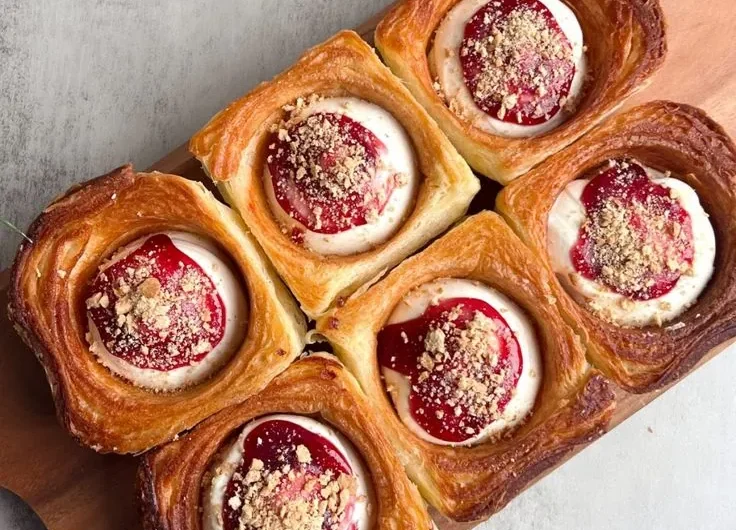

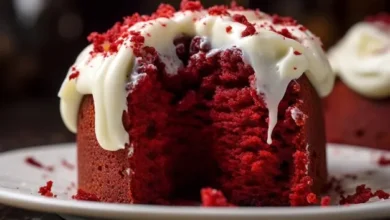
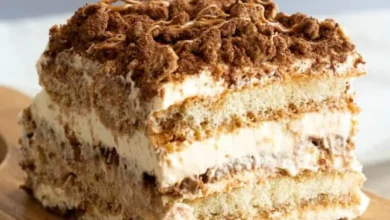
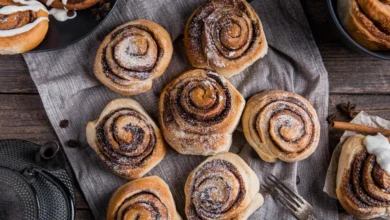

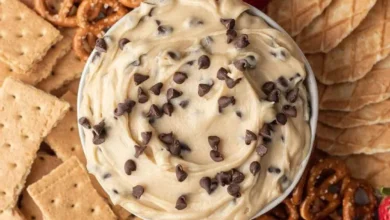
One Comment